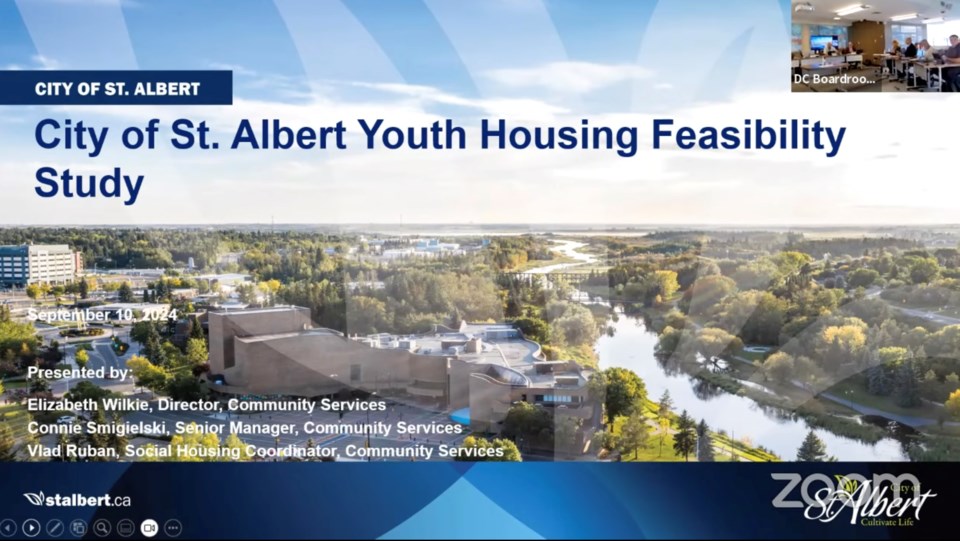If you have a house in St. Albert you’re willing to donate to a teen shelter, now is the time.
Sitting as the standing committee of the whole, city councillors on Tuesday voted to direct staff to “investigate interest from operators or partners for the provision of youth transitional housing,” and update them no later than the second quarter of 2025.
The vote came after Elizabeth Wilkie, director of Community Services, and others presented Phase 2 of their youth transitional housing feasibility study.
Councillors received Phase 1 of the report in May. At the end of that presentation, some said they were looking forward to the possible solutions Phase 2 might provide.
But while shelters of three different sizes were roughly costed out in the report, the process of writing it led FCSS to a murkier position than they had hoped.
Wilkie said St. Albert is not alone as a municipality trying to navigate how to respond to people in crisis without breaking the bank long-term, or in dealing with uncertainty over what level of government is or should be responsible for a given product or service in this space.
“The scope of the work is constantly changing,” she said. “What’s contributing to why these young people or anyone is experiencing houselessness is changing. Which programs and funding sources are available is changing constantly.
“I wanted this report to be a clear and actionable path forward that we could just make decisions or hand it over to another entity that just wants to give us money and help people in our community with a quick and effective and sustainable solution; that we’d turn over a rock no one had ever before, find untapped opportunities; and that we would unlock how to get to that next step with the least amount of pain and stress and maybe frustration.
“That’s not what happened.”
Wilkie said Community Services learned there are social service providers/operators who are interested in partnering to deliver services considered wraparound to traditional housing and that other municipalities in the region are keen to find collaborative solutions to a challenge they all share.
“Those conversations had happened previously but not in the (context of), ‘We’re ready to jump in, we’re ready to figure this out,’ so that is an exciting outcome of this Phase 2 work.”
City staff didn’t have an update to the estimate of how many unhoused young people there are in St. Albert they provided earlier this year, which was between "fewer than a dozen and more than 30."
Three possibilities for a new transitional youth shelter were presented, with obvious preference given to the larger proposals (these costs would be borne by an operator, not the city):
- Converting an existing four-bed house that would cost $1.1 million to retrofit and $598,000 or $150,000 per bed to operate yearly;
- Building a new 10-bed facility on donated land that would cost $4.2 million to build and $1.2 million or $121,000 per bed to operate yearly;
- Building a new 16-bed home on donated land that would cost $5.2 million to build and $1.5 million or $94,000 per bed to operate yearly.
By comparison, a 27-bed shelter in Cold Lake (which services the surrounding First Nations also) costs $360,000 per year to operate, a 35-bed combination shelter in Grande Prairie costs $2 million to operate, and a 12-bed shelter in Red Deer costs $875,000 to run.
Coun. Sheena Hughes said she appreciated the detail in those figures, because to this point the perspective has been very high-level.
“I do appreciate you went to that kind of detail to try to figure this out,” she said.
The committee heard smaller homes like the four-bed tend to be occupied immediately with no room for growth. Then there’s the obvious per-bed cost, which is much easier to swallow at 16 beds than four.
They also heard there are plenty of data that demonstrates spending on youth homeless prevention today saves tomorrow: according to Inn Out of the Cold in Calgary, every dollar invested in social prevention strategies creates nearly $7 of downstream social and economic value in return. A study from BC Housing showed $4.36 in created value per dollar invested in dedicated-site supportive housing.
There are a handful of keystones that would have to fall into place for a new youth housing project to materialize in St. Albert, and to succeed in the long-term, including:
- A project champion (that is not the city),
- A suitable site,
- Access to affordable (possibly donated) land,
- An experienced operator, and
- Capital (construction), startup and/or operating funding.
Coun. Wes Brodhead said he’d prefer a new shelter find its home in St. Albert. The committee heard that since the dearth of youth transitional housing stretches beyond St. Albert across at least the Edmonton region, ultimately, a new shelter may be built in a different municipality.
“If you build it, they will come and they will come from everywhere because, especially for youth transitional housing, there’s so little of it in the region,” said Connie Smigielski, senior manager, Community Services.
Coun. Natalie Joly presented the motion for a vote. The housing discussion followed a presentation on the city’s social services road map document.
“When I think about the social road map discussion, I’m strongly aware that this project targets many of the identified issues in that report related to youth, poverty, inclusion, accessibility and safety, so this is an easy recommendation to support,” she said. “The hard decisions are going to come when we have to have courage in terms of the NIMBY (not in my backyard) arguments (and) when we hear real budget implications. I look forward to those discussions happening in St. Albert.”




